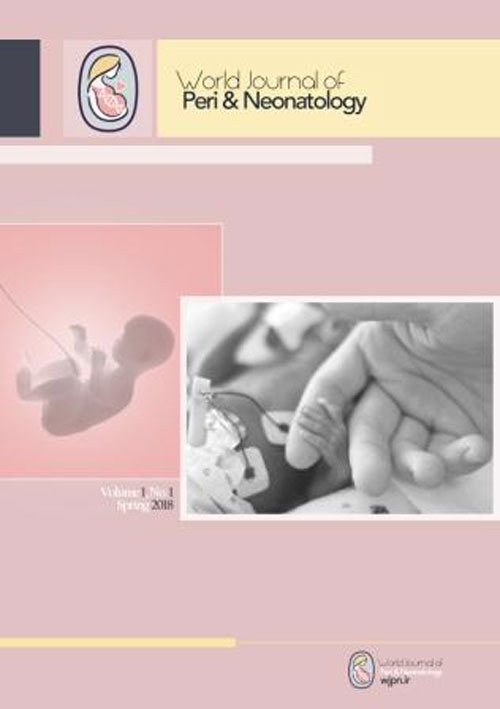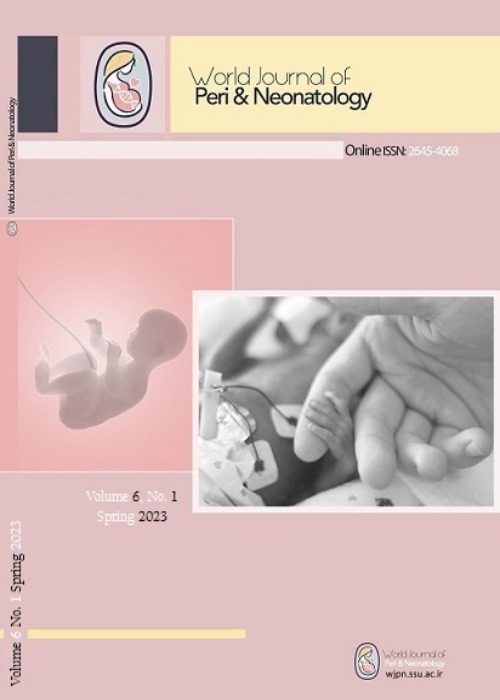فهرست مطالب

Journal of World Journal of Peri and Neonatology
Volume:4 Issue: 2, Summer-Autumn 2021
- تاریخ انتشار: 1400/12/15
- تعداد عناوین: 8
-
Pages 70-75BackgroundPremature rupture of membranes (PROM) is known as one of the leading causes of morbidity and mortality among pregnant women. So, the aim of this study was to evaluate the diagnostic value of quantitative and qualitative vaginal fluid β-HCG for the detection of premature rupture of membranes.MethodsOne hundred pregnant women with gestation age between 28 and 37 weeks were divided into three groups: confirmed PROM group (34 cases), suspected of PROM (36 cases), and intact membranes (30 cases). Those pregnant women with positive pooling tests were considered as confirmed PROM, while those with the decreased amniotic fluid index, positive nitrazine, or ferning were included in suspected PROM group. Notably, pregnant women with no complaints or complications were enrolled as the control group. Five ml sterile normal saline was injected into the posterior fornix of vagina, vaginal fluid was aspirated, and β-HCG measurement was then performed both quantitatively and qualitatively using ELISA and baby check kits, respectively.ResultsThe cut-off value for quantitative β-HCG was determined as 66 mIU/m. The sensitivity, specificity, positive predictive value (PPV), negative predictive value (NPV), and accuracy of quantitative β-HCG were calculated as 97.05%, 100%, 100%, 96.77%, and 98.43%, respectively. Besides, the qualitative vaginal washing fluid β-HCG using Baby check with the threshold value of 25 mIU/ml had 94.11% sensitivity, 93.33% specificity, 94.11% PPV, 93.33% NPV, and 93.75% accuracy.ConclusionQuantitative and qualitative vaginal washing fluid β-HCG measurements are accurate, reliable, and useful tests for the diagnosis of PROM.Keywords: Premature rupture of membranes, Beta-human chorionic gonadotropin, Amniotic membranes, Vaginal fluid
-
Pages 76-81BackgroundEarly diagnosis and treatment of congenital hypothyroidism is the primary goal of neonates and children screening programs. This study aimed to evaluate and compare developmental skills in children with early-treated congenital hypothyroidism with healthy children using the Ages and Stages Questionnaires test (ASQ).MethodsA total of 40 neonates with congenital hypothyroidism diagnosed during neonatal screening (thyroid stimulating hormone (TSH) > 10 mu/l) who were treated with Levothyroxine (10-15µ/kg) promptly within the first month of birth (after treatment, TSH < 4 mu/l) were evaluated for developmental skills using the ASQ test at 4, 8, and 12 months of age. The control group consisted of 40 healthy children matched with the case group in terms of age, sex, and socio-economic status. Chi-square and Fisher exact test were used with SPSS statistical software version 21 for analyzing the results.ResultsThe overall mean ASQ score in case group was 262.7 ± 9.07, and in control group was 261.2 ± 8.49, which indicates no significant difference (P > 0.05). The ASQ test score increased significantly by age (P < 0.05). The girls' mean score of the ASQ test was significantly higher than boys in the case group (P < 0.05). Moreover, no significant difference was observed between the mean ASQ test score and the delivery type (P < 0.05).ConclusionThis study showed that the developmental skills in children under-treatment of congenital hypothyroidism were at the standard level, indicating the effectiveness of early treatment to avoid developmental disorders.Keywords: Hypothyroidism, Children, Developmental disorder, Ages, Stages Questionnaires
-
Pages 82-87BackgroundInborn Errors of Metabolism (IEMs) are a group of heterogeneous disorders resulting from absent or decreased metabolic pathway activity. They are typically rare, but are more common in consanguineous population.MethodsIn this cross sectional study, all children with symptoms suspicious for IEMs who referred to Shahid Sadoughi Hospital in Yazd during a 5-year period (2013-2018) were investigated for metabolic diseases. The diagnoses were further confirmed by clinical symptoms and biochemical analysis. IEMs type, age of diagnosis, family history and disease outcome were recorded.ResultsIn this study, 39 symptomatic children with a median age of 48 months were diagnosed with different types of metabolic diseases. About 64.1% of the patients were born from consanguineous marriage. The patients’ mean age at the time of diagnosis was 25.3 ± 5.1 months. The most frequent disorders were organic acidemias which were found in 12 patients (30.8%), lysosomal storage disorders which were found in 8 patients (20.5%), and amino acid disorders excluding phenylketonuria which was found in 8 patients (20.5%). Most of the patients (60%) were diagnosed before the age of 6 months. Mortality from metabolic disorders was 5 (12.8%). The rest of the patients (22 cases, 56.4 %) had developmental delay.ConclusionIt was found that the prevalence of inherited metabolic disorders was higher in countries with a high prevalence of consanguineous marriage, such as Iran. More extensive newborn screening is needed for ensuring early diagnosis of these patients given that delay in diagnosis of this disorder may be associated with high morbidity and mortality.Keywords: Inborn Errors of Metabolism, Metabolic Disease, Frequency, Consanguineous Marriage, Yazd
-
Pages 88-103Background
Gestational diabetes mellitus (GDM) is a complex metabolic disorder of pregnancy with a strong genetic predisposition. GDM is associated with complications during pregnancy and increased risk of type 2 diabetes later in mothers and develops a vicious cycle of metabolic diseases for future generations. Evidence is accumulating that women with genetic variants at transcription factor 7-like 2 (TCF7L2) gene are more susceptible to GDM. The aim of the current meta-analysis was to assess the association of the TCF7L2 polymorphisms with GDM risk.
MethodsPubMed, Web of Science, Embase, SID and CNKI databases were searched to identify relevant studies up to November 01, 2020. Using the fixed-effect or random-effect model, the pooled odds ratio and its corresponding 95% confidence interval were computed.
ResultsA total of 38 case-control studies including 24 studies with 6021 cases and 13289 controls on rs7903146, eight studies with 2404 cases and 2615 controls on rs12255372 and six studies with 1357 cases and 2858 controls on rs7901695 polymorphism were selected. Pooled data showed that there was a significant association between the TCF7L2 rs7903146, rs12255372 and rs7901695 polymorphisms and an increased risk of GDM in whole population. Stratified analysis showed that the TCF7L2 rs7903146 polymorphism was associated with GDM in Caucasian, mixed and Chinese women, but not in Asians. Moreover, the TCF7L2 rs12255372 polymorphism was associated with GDM in Asians and Caucasians women with GDM.
ConclusionThe combined data indicated that the TCF7L2 rs7903146, rs12255372 and rs7901695 polymorphisms were associated with a significant risk of GDM in whole population, especially in Caucasian women.
Keywords: Gestational Diabetes Mellitus, Metabolic Disorder, TCF7L2, Risk, Polymorphism -
Pages 104-114Background
Most pregnant women with COVID-19 develop less severe form of the disease, with few cases of severe maternal morbidity and mortality, or perinatal deaths. This meta-analysis was conducted to evaluate the frequency of miscarriage in pregnant women affected by the SARS-COV-2 infection.
MethodsA comprehensive search was performed in online databases to identify all relevant studies published up to 5th March 2021. Case-control studies and case series reported the frequency of miscarriage in pregnant women with COVID-19 was selected.
ResultsA total of 22 studies with 8591 infected pregnant women and 141 abortions were selected. The frequency of miscarriage was 3.9% (95% CI 0.023-0.063) in infected pregnant women with COVID-19. It had the highest frequency in Asian (6.3%) followed by European (2.9%), West-Asian (2.5%) and Caucasian (2.3%) infected pregnant women. Moreover, stratified analysis by country showed that the frequency of miscarriage is the highest in Chinese (11.3%) followed by Italy (11.2%), India (2.7%), Turkey (2.2%), USA (1.2%) and France (0.9%) infected pregnant women.
ConclusionOur pooled data revealed that the frequencies of miscarriage in pregnant women with SARS-COV-2 infection were 3.9%.
Keywords: SARS-CoV-2, COVID-19, Pregnancy, Abortion, Miscarriage, Frequency -
Pages 115-123Background
Jaundice is a common life-threatening disease in the neonates. Several factors play a role in the etiology of jaundice. Sepsis is a possible cause of jaundice after blood group incompatibility. Bacterial infection and jaundice may be associated with higher morbidity. To date there exists no systematic review and meta-analysis that evaluated the Prevalence of sepsis in Iranian newborns with jaundice. Thus, in this study we evaluated the prevalence of sepsis among Iranian newborns with jaundice.
MethodsA comprehensive literature search in Persian and English was performed on PubMed, Web of Sciences, Scopus, Google Scholar, Magiran and Scientific Information Database (SID) till July 2021. Data analysis was done by CMA version 2.0 software.
ResultsA total of eight publications with 4434 newborns with jaundice out of approximately 105 retrieved articles were selected. 211 neonates had sepsis. Pooled data revealed that the overall prevalence of sepsis among Iranian newborns with jaundice was 4.7% (95% CI 0.041-0.202, P ≤ 0.001) and there was no publication bias.
ConclusionThis study showed that the prevalence of sepsis among Iranian newborns with jaundice was 4.7% and sepsis was a plausible reason of unexplained Hyperbilirubinemia among newborns with jaundice. To better understand the relationship between jaundice and sepsis, more studies with large sample sizes are needed.
Keywords: sepsis, Neonates, Jaundice, Hyperbilirubinemia, Iranian, Prevalence -
Pages 124-129Background
Although COVID-19 in pregnant women and their neonates has been verified, its impact on neonates born to infected mothers has remained unclear and there is not enough evidence about how this vertical transmission occurs.
Case ReportIn this case report, we explained that a neonate girl was born to a mother with COVID-19 infection. Our main goal was to focus on the follow-up and outcome of the neonate. The neonate was at GA = 28 weeks who was born by cesarean section due to respiratory distress of her mother. Also on day 18, she experienced recurrent unilateral seizures so the sample of her cerebrospinal fluid (CSF) was examined.
ResultsThe neonate had a positive reverse transcription polymerase chain reaction (RT-PCR) test for COVID-19, while this neonate after birth, due to mother’s positive PCR, immediately was isolated from the operating room. The neonate’s nasal sample was positive for more than 18 days. Twenty-six days after birth, the neonate was re-evaluated for clinical laboratories, all of which were normal and she had favorable outcomes.
ConclusionIn our case report despite the neonate was premature and had seizures, she had favorable outcomes because we quickly started treatment and supportive measures. It is recommended; Symptomatic neonates born to infected mothers must be evaluated for COVID-19 to start proper treatment and quarantine. Additional studies are needed to evaluate the outcomes of COVID-19 in neonates and how to minimize the risk of this disease in neonates.
Keywords: Neonatal SARS-Cov-2 Infection, COVID-19, Clinical Presentation, Outcome, Vertical transmission -
Pages 130-133Background
Niemann-Pick disease type C (NPC) is an autosomal recessive neurovisceral lysosomal storage disorder resulting from mutations in either the NPC1 or the NPC2 gene. It shows a broad spectrum of clinical phenotypes and a variable age at diagnosis. As most patients have normal routine examinations (MRI, cerebrospinal fluid, electrophysiology, and so on), its diagnosis is often a challenge, and the start of treatment delays for several years.
Case ReportWe reported a 9-year-old boy who presented with Stuttered speech, hepatosplenomegaly, and up and downward gaze palsy whose Niemann Pick disease was not diagnosed during infancy due to unawareness. Dried blood spot assay and genetic study confirmed the diagnosis of Niemann Pick disease type C.
ConclusionDue to the high rate of consanguineous marriages and NPC presentation with atypical phenotypes, more educational programs for pediatricians, hematologists, neurologists, endocrinologists, and clinicians help the appropriate and timely diagnosis and prevent another involved sibling.
Keywords: Niemann-Pick, Autosomal recessive, Neurovisceral, Lysosomal, Genetic disorder, Splenomegaly


